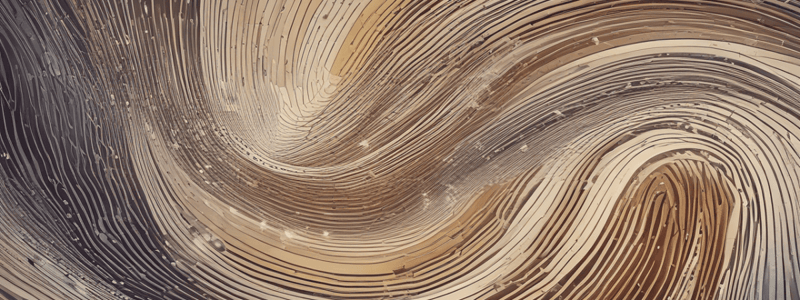Podcast
Questions and Answers
What is the main difference between transverse and longitudinal waves?
What is the main difference between transverse and longitudinal waves?
- Transverse waves have higher frequency, while longitudinal waves have lower frequency.
- Transverse waves are mechanical waves, while longitudinal waves are electromagnetic waves.
- Transverse waves have particles vibrating perpendicular to wave propagation, while longitudinal waves have particles vibrating parallel to wave propagation. (correct)
- Transverse waves are always sound waves, while longitudinal waves are always light waves.
What type of wave does not require a medium to propagate?
What type of wave does not require a medium to propagate?
- Mechanical wave
- Longitudinal wave
- Transverse wave
- Electromagnetic wave (correct)
What is the term for the highest point in a wave?
What is the term for the highest point in a wave?
- Wavelength
- Trough
- Crest (correct)
- Amplitude
What characteristic of a wave is measured in hertz (Hz)?
What characteristic of a wave is measured in hertz (Hz)?
What determines the amount of energy carried by a wave?
What determines the amount of energy carried by a wave?
What happens to the particles in the medium when a wave passes through?
What happens to the particles in the medium when a wave passes through?
What type of wave is sound?
What type of wave is sound?
What is the relationship between wavelength and frequency?
What is the relationship between wavelength and frequency?
What is the term for the distance between two successive identical points in a wave?
What is the term for the distance between two successive identical points in a wave?
What do waves carry through objects?
What do waves carry through objects?
What primarily describes the motion occurring during vibration?
What primarily describes the motion occurring during vibration?
Which of the following processes produce sound?
Which of the following processes produce sound?
What is a key characteristic of periodic motion?
What is a key characteristic of periodic motion?
In the context of vibrations and waves, what is the relationship between the two?
In the context of vibrations and waves, what is the relationship between the two?
What happens to a spring-mass system when it is disturbed?
What happens to a spring-mass system when it is disturbed?
Which example is least associated with vibrations?
Which example is least associated with vibrations?
How is sound created when a guitar string is plucked?
How is sound created when a guitar string is plucked?
What is a common example of a phenomenon that exhibits vibrations?
What is a common example of a phenomenon that exhibits vibrations?
Which of the following waves is primarily generated by vibrations?
Which of the following waves is primarily generated by vibrations?
What occurs after a spring-mass system is disturbed and allowed to vibrate?
What occurs after a spring-mass system is disturbed and allowed to vibrate?
Flashcards are hidden until you start studying
Study Notes
Vibration Overview
- Vibration refers to repeated back-and-forth motion of a particle displaced from its equilibrium position.
- It demonstrates periodic or repetitive motion, characterized by regular time intervals.
- Common examples include tuning forks, pendulums, and loudspeakers.
Sound Production from Vibrations
- Sound is produced by the vibrations of a source, displacing particles in a medium.
- When a guitar string vibrates, it creates alternating compressed and spread-out air particles.
- This series of vibrations transfers sound waves that can be perceived by human ears.
Spring-Mass System
- A block on a spring illustrates vibration when disturbed, stretching and contracting around its equilibrium position.
- Continuous expansion and contraction occur until the system eventually stops vibrating.
Connection Between Vibrations and Waves
- Vibrations serve as sources of waves, which are disturbances traveling from one point to another.
- Waves transfer energy, seen in sound waves, water waves, and light.
Types of Waves
- Transverse Waves: Particles vibrate perpendicular to wave propagation (e.g., light).
- Longitudinal Waves: Particles move parallel to wave propagation (e.g., sound waves).
Mechanical vs. Electromagnetic Waves
- Mechanical Waves: Require a medium to travel (e.g., sound waves, waves on a string).
- Electromagnetic Waves: Can travel through a vacuum, encompassing radio waves, microwaves, and visible light.
Parts of a Wave
- Crest: The highest point of a wave.
- Trough: The lowest point of a wave.
- Wavelength: Distance between two successive identical points (e.g., crests or troughs).
- Amplitude: The maximum distance from the equilibrium position; indicates energy level.
Frequency
- Frequency is measured in hertz (Hz) and refers to the number of waves passing a fixed point.
- Wavelength and frequency are inversely related; longer wavelengths result in lower frequencies and vice versa.
Energy Transfer through Waves
- Waves carry energy through mediums without transferring matter itself.
- In sound waves, air particles oscillate while returning to their original positions after energy transfer.
- Water surface disturbances show similar behavior, with particles mainly bobbing up and down.
Amplitude and Energy Correlation
- The energy carried by a wave is reflected in its amplitude; higher amplitude means higher energy.
- Observations indicate that larger disturbances, like a boulder thrown into water, produce larger wave heights than smaller disturbances, like a pebble.
Studying That Suits You
Use AI to generate personalized quizzes and flashcards to suit your learning preferences.




